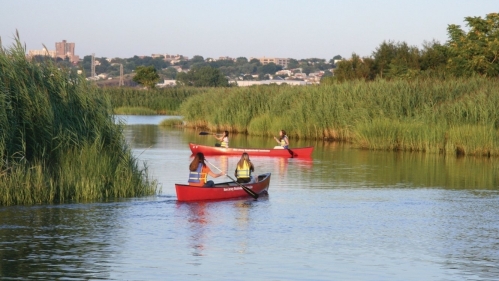Researcher Champions NY/NJ Estuary, Winning Designation as "Hope Spot"

A Rutgers University—Newark researcher who for decades studied the New-York New Jersey Harbor Estuary, once a notorious dumping ground for waste, has successfully won its designation as a “Hope Spot’’ by the international conservation organization Mission Blue.
It is one of the first urban estuaries to receive the designation, which commemorates its resurgence and is intended to help boost conservation efforts, said Judith S. Weis, a Professor Emerita of Biological Sciences at Rutgers University-Newark, who spent much of her research career studying the estuarine animals and marsh plants in the Harbor Estuary.
The waterway, which includes the Meadowlands, once renowned for its pollutants, has experienced a rebirth in the past 40 years as a result of state and federal efforts to ban contaminants and encourage thriving plant and animal life, including the return of whales and many bird and fish species. The work of dozens of non-governmental organizations throughout the estuary has also been essential to the recovery.
“Years ago, I remember being nervous about wading in the water and mud to collect samples. “It was incredibly contaminated,’’ said. Weis, “There was little public access and few public parks. In any case, few people would have been interested in access to highly polluted, smelly waters.”
The area’s transformation, and the desire to protect it from further development and other environmental threats, led Weis to seek Mission Blue’s support. “People are now kayaking and swimming there. We want the public to understand how far we have come, which gives us hope for the future,” says Weis. “However, there is much more work to be done. For those of us who remember the bad old days.”
Weis has been honored as a Hope Spot Champion by Mission Blue, along with Rob Pirani, Program Director, NY/NJ Harbor & Estuary Program (HEP), who also worked to get the Hope Spot designation. As “champions,’’ they are recognized for their work to connect their community of urbanites with the natural world around them through campaigning for continued improvement in water quality, habitat restoration, and community engagement programs.
Throughout more than three centuries, the water in the estuary has degraded due to pollution and habitat destruction from activities like untreated sewage, industrial waste dumping, garbage dumps, dredging, and development.
The quality of the water hit its lowest point in the 1960s, a turning point in which New York State voters passed the Pure Waters Bond Act in 1965 and the federal Clean Water Act of 1972 was passed when several public and private NGOs and agencies began focusing on its recovery and pushed improved regulations and enforcement, coastal land use policies, public access, research, and education. In the half-century since then, water quality and biodiversity improved immensely.
Dr. Sylvia Earle, founder of Mission Blue, says the area is proof that even the most polluted environments can be reclaimed. “This place is highly urbanized; located in the largest metropolitan region in the United States. It is not a place that you would think of normally as a reason for hope – but a transformation is taking place,’’ she said. “It’s evidence of what people can do when they care and when people put in the work for a better place for nature and for humans. It is achievable.’’
Being named a Mission Blue Hope Spot raises global awareness of an area through the organization’s multimedia campaign and often leads to increased conservation efforts, said Weis, a former President of the American Institute of Biological Sciences, who received the Merit Award from the Society of Wetland Scientists in 2016.
The Mission Blue alliance includes more than 250 ocean conservation groups and like-minded organizations, from large multinational companies to individual scientific research teams.
Weis’s and Pirani’s goals for the Hope Spot include stimulating more habitat restoration, reducing pollution, especially plastics, and educating diverse groups about the estuary. “We want to improve public access to the estuary from underserved neighborhoods that do not yet have easy access, but yet have often carried the weight of degradation”, Weis says. “We work with the many public outreach groups in New York and New Jersey who are already working on these issues to help shine a light on the potential opportunities.”
A great concern for Weis and others is a proposal to transform Caven Point, a portion of Liberty State Park in Jersey City, into a golf course, which would replace the coastal marshes, tide pools, mud flats and maritime forest that exist there. .
“That would be just as bad as paving it over,’’ said Weis, who hopes the Hope Spot designation will prevent development of the spot.
“The NY-NJ Harbor Estuary serves as a connector, bringing together diverse communities, diverse interests, and millions of people and their cultures. We want the people who pass through or over it daily to appreciate that it once was an open sewer and is now an ecological treasure.”


